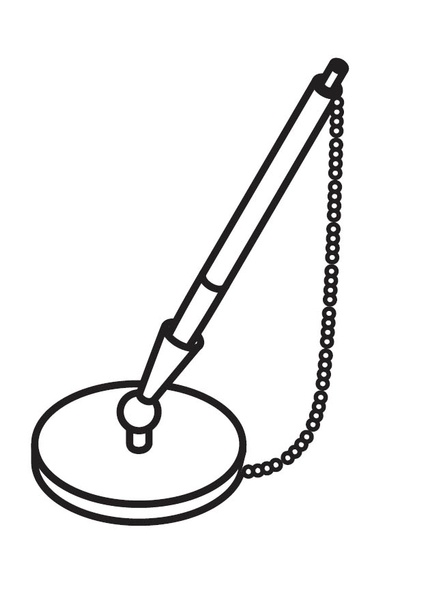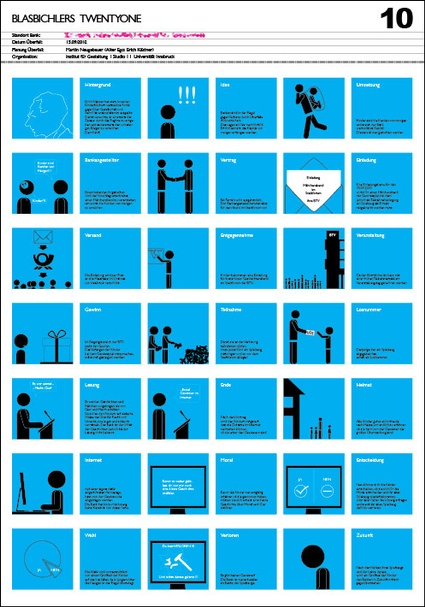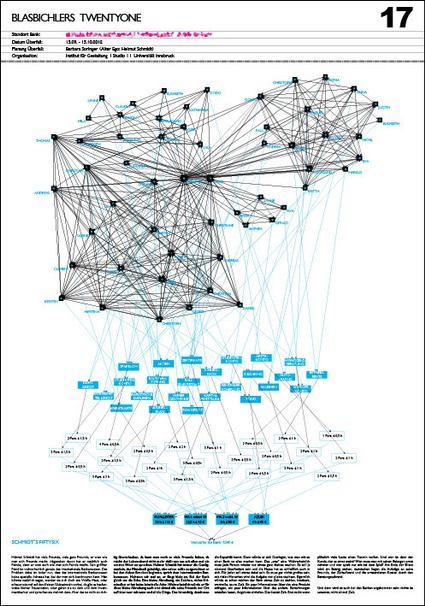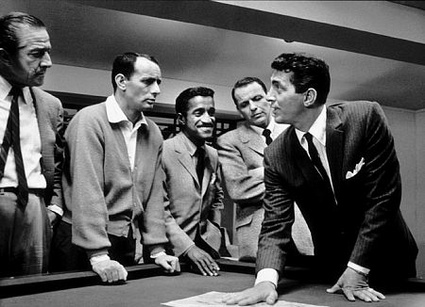A couple of weeks ago, while i was visiting him at the School of Design and Crafts at the University of Gothenburg in Sweden, Otto von Busch told me about an extraordinary experiment that architect Armin Blasbichler had carried out with 21 of his architecture students at the University of Innsbruck. I didn’t get much details, except that Blasbichler’s students had been assigned to pick up a bank in the city, study it, identify its Achilles’ heel and plan a bank robbery.
The best way to know more about the project was to interview the mastermind behind it…
 Blasbichlers Twentyone. Credit photo: Christian Flatscher
Blasbichlers Twentyone. Credit photo: Christian Flatscher
If i understood the project well, you ran a seminar at the University of Innsbruck where 21 architecture students, the famous “Blasbichlers Twentyone”, were given the assignment to study the plans of the bank, spot their weaknesses and then take advantage of them to make a bank robbery in which however, they could not steal money. Is that so? Could you give us a few more details about the project?
The project is the result of a semester-long design research course at the Institute of Design/ Studio1 at the University of Innsbruck. The course was conceived as a laboratory to investigate in the continuing marginalization of the role of the architect, the sheer new mass of young architects produced by Universities trying to find a stand, the potentials of role play and last but not least the bold attempt to run an academic course as a profit oriented business model. For the motivation of a young aspiring architect I would put it a little more dramatic:
“…Yo, we gotta take the power back! Bam! Here’s the plan.” (Rage Against the Machine,
Take the Power Back)
The plan:
At first glance the attempt to plan a bank robbery might sound like a post-adolescent prank. But it’s not, of course. Such a project claims most of the core competences of an architect. i.e. research and value the site (if of necessity), find out weak/strong aspects, think, imagine, anticipate, sense and develop a concept, sketch, think, design, rethink, reimagine etc., prepare action plan documentation, plan the time schedule, the costs. And well, in this case also an escape plan was asked.
Role play:
Before the actual task the students were asked to present a paper of the working methods of a personality of their choice. The choices ranged from leading figures from politics, sports, arts, economy, science, etc. These fictional personas have been called alter-egos. Subsequently and together with their alter-egos, the students had to break the task.
The task:
Develop a bank robbery plan for a bank branch within the city limits of Innsbruck. Use only information you find out yourself. Your alter-ego is your team mate, listen to what he/she says. Do not tell bank staff who you are and what you intend to do. Identify weak points of the chosen bank branch. Develop a concept to detract assets from the bank according to the weaknesses identified. Include action-, time-, and escape plan in a paper document of 70x100cm of size. Use graphic design techniques and text in order to provide a viable instructions manual document. Calculate or estimate the potential loss of assets.
21 bank branches vs. 21 architecture students.
 Blasbichlers Twentyone. Credit photo: Christian Flatscher
Blasbichlers Twentyone. Credit photo: Christian Flatscher
 Blasbichlers Twentyone. Credit photo: Christian Flatscher
Blasbichlers Twentyone. Credit photo: Christian Flatscher
I suspect that you didn’t warn the banks about the performance. Wasn’t the
University of Innsbruck a bit worried about your plans?
The single banks where not advised or involved in the project simply because I wanted to provide an authentic general framework. At some point in the research phase some students came up to me, worried about the fact that they are going to do something illegal. However, the University’s legal department approved the project with some formal and privacy restrictions. Any time you put to the test your own imagination of things with the prevailing parameters of the real, things become potentially illegal. Architecture is always illegal.
How did the bank managers and employees react after they realized what happened?
The results were presented within the context of an exhibition in an art gallery in Innsbruck. That was the moment where bank representatives and safety officers came to see the poster size “emergency plans”, for the first time. There was a mixed feeling of incredulity about the feasibility of the plans and at the same time a sense of appreciation for the inventiveness of the authors. Though tailored for specific banks branches in specific locations within specific conditions all plans showed a general validity. As a thank-offering for their involuntary participation to the project they all received a copy of the emergency plans for free, as it wasn’t intended as a blackmailing event. But the key question for me was: is this immaterial architecture, the information provided by unsolicited architects, is architecture itself of any monetary value? To my surprise most of the banks appreciated the outcomes and gave a financial contribution. With that money we were able to finance the exhibition, material expenses and partly the expenses for the publication of the book. All in all a leveled risk capital venture.
 Blasbichlers Twentyone. Image courtesy of Armin Blasbichler
Blasbichlers Twentyone. Image courtesy of Armin Blasbichler
What did the students steal by the way? Do you have some examples of what they brought back from their break-ins? Any anecdotes about some of the most original/spectacular/curious robberies? Did they get to keep anything in the end?
The students didn’t steal anything. Their task was not to steal but to examine and exploit the weak points for their purposes to provide feasible emergency plans. The objectives ranged from assets like time, space, image, future clients, electric power, etc. up to the one student, who celebrates with unbelievable virtuosity the theft of the typical chained ball pen on the counter, an icon of worthlessness and petty-minded communication strategies. In any case, cash money assets were of a subordinate interest. You can find all instructions plans in the publication “Blasbichlers Twentyone”.
 Blasbichlers Twentyone. Image courtesy of Armin Blasbichler
Blasbichlers Twentyone. Image courtesy of Armin Blasbichler
I’m particularly interested in the result from these performances and researches. A series of plans and a book. i saw a few examples over here but could not see the details. Could you describe the sort of graphics and plans that the students created?
You are talking about number 14 and number 17. These two students have been adopting business models and principles which are written into the genetic code of the banking sector, namely “make money” and “time is money”.
Number 14 did not care about a typical bank robbery on a specific site. His approach relates to a quote by Bertolt Brecht: “What is robbing a bank compared to founding a bank?” In doing so he sets the heist on a higher level of sophistication, perspective and productivity. The plan gives detailed instructions how to found a hedge fund from scratch with all the credentials one needs to do so. The business field of the fund is allocated in the banking safety sector. In reality the fund is intended to take profit from real bank robberies on specific sites. As an investor you can “bet” either on a successful or a failed robbery. According to the business term of the fund one can earn or lose money through a criminal act without getting one’s hands dirty. In other words, “robbing a bank” with its own resources. The student outlines the facility to found a hedge fund and pays reference to real business processes and implications in the investment sector, i.e. the Euro break down a couple of months ago, the intensive pressure the financial market is putting on Greece as we speak, just to name a few.
 Blasbichlers Twentyone. Image courtesy of Armin Blasbichler
Blasbichlers Twentyone. Image courtesy of Armin Blasbichler
Number 17 was, according to the bank officials, the most alarming one as it is achievable with no particular effort. Basically the student steals time. She shows how one can jam a banks activity up to a halt and at the same time bring along consistent losses of money. The effect of this apparently trivial approach is startling and I can’t go to enlarge it at this point. Check the book for the “source code”…
One would expect architecture students to build banks, not to rob them. What did the students learn in this process of masterminding bank robberies?
Architecture is much more than designing a building, it’s about the making of the imagination. In this sense architecture is more related to the arts and the financial sector than one might think. Banking and architecture are of a kin.
 Screenshot from the movie Ocean’s Eleven (1960)
Screenshot from the movie Ocean’s Eleven (1960)
Nowadays i suspect that people have very little sympathy left for banks. Was there any political or ethical reason why you decided to target banks?
You can’t do without banks in prevailing global societies. Banks are not the enemy; rather they have become the fortresses of desires, the keeper of dreams, hardly accessible and locked-off from the public, although propagating transparency. From this point of view banks are a rewarding topic of research, also for architects. Banks constitute an almost invisible net of power structures. To examine these structures is to bring to light something which has been buried and set out of balance. Unfolding a system is not a crime, it rather adjusts the attention.
The approach of the Twentyone is comparable with the attitude of hackers. Without the commitment of hackers today you would not be able to send an email without somebody reading along, you would not be able to make a secure online purchase or bank online. No Firefox, no Open Office, no Linux – just to name a few – would be available. Hackers usually are related to an information technology security context. Why not set their working method to other topics and disciplines – “hitchhacking”?
In this sense the Twentyone are a non-institutionalized, slightly profit oriented breed of security “hitchhackers”. A 21-architect resides in anyone of us and when you team up with your hidden alter-ego you make 42. According to Douglas Adams, with 42 then you can answer the ultimate questions of life, the universe and everything.
Thank you Armin!
 Blasbichlers Twentyone – the book
Blasbichlers Twentyone – the book
Paperback: 104 pages, richly illustrated. With texts by Armin Blasbichler, Otto von Busch,
Hubert Salden, Klaus Schönberger
Publisher: innsbruck university press, march 2011
Language: German, English
ISBN-10: 3902719958
ISBN-13: 978-3902719959
The book is more than a compilation of 21 instruction plans to detract assets from a bank. It is a must have for any aspiring bank robber and at the same time a blueprint for banks to take precautions.
—————
Armin Blasbichler (*1970) is an architect, curator and artist, trained at the University of Innsbruck and graduated from the Chelsea College of Art and Design, London with an MA in design for the environment. Beside his studio practice, which is pivoted between the poles of architecture, applied arts and design, his teaching and research assignments included University of Innsbruck, TU Berlin and European Academy Bolzano. Currently he is a visiting professor at the Faculty of Design and Art at the Free University of Bolzano, Italy.
